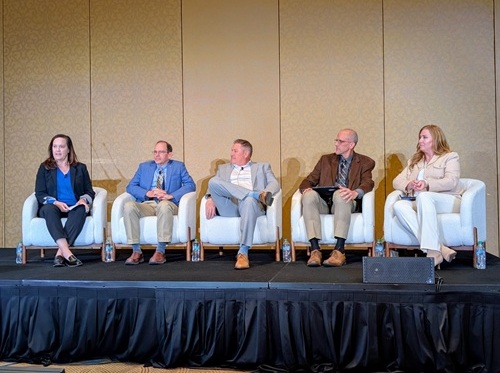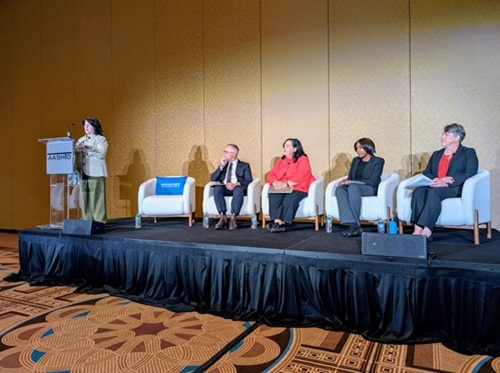At the American Association of State Highway and Transportation Officials 2025 Annual Meeting in Salt Lake City, a knowledge session detailed how states can leverage transportation infrastructure to foster regional growth and guide land development decisions.
[Above photo by AASHTO]
Sheilah Brous, senior director of mobility for North America Mobility at Bentley Systems Inc. – the session’s sponsor – moderated a panel that featured Marie Therese Dominguez, commissioner of the New York State Department of Transportation; Jennifer Toth, director of the Arizona Department of Transportation; Regina Colson, manager of system performance for the Florida Department of Transportation; and Glenn Grimshaw, program director for infrastructure at the National Governors Association (NGA).

“We all know that transportation is about moving people and things that we need, but it’s more than roads and rails,” explained Bentley’s Brous.
“It’s a catalyst for economic vitality. And the decisions we make about where and how to invest in transportation infrastructure have profound impacts on land use, business development, housing, and community well-being,” she said. “Transportation projects – from freight corridors to transit-oriented development – can unlock economic potential, support sustainable land use, and foster resilient communities.”
NGA’s Grimshaw added that there are distinct revenue opportunities for state departments of transportation where land use planning is concerned, as well.

“For example, transportation rights-of-way can potentially support energy transmission lines, water systems, and fiberoptic [cable] deployment, which is critical for data center growth,” he stressed. “There’s a lot of interest in the potential of utilizing existing assets while also creating a revenue stream for state DOTs.”
Meanwhile, NYSDOT’s Dominguez emphasized that investing in transportation itself is an investment in economic development and fundamental quality of life improvements.
“It also gets to kind of how we look at everything writ large from planning and land use to our larger capital investment plan,” she said.

“Investing in transportation fundamentally allows people to move safely. And that’s really core to quality of life, because that’s what everyone wants,” Dominguez noted. “We want to be able to thrive with our families – and making sure that we’ve got safe, reliable transportation in all modes is core to all that.”
Arizona DOT’s Toth said there are two ways to achieve such goals where transportation is concerned. “There’s very proactive methods and very reactive methods that we are constantly looking at in terms of land use,” she explained. “For example, is the land being used first and then the transportation connects to it – in which case we have a funding issue – or is it the vice versa, where we plan land use and transportation connections together?”
Toth pointed out that local collaboration is critical to how transportation investment and land use work together to improve and enhance economic and quality of life improvements.
“If we can be proactive in our discussions with our local governments, if we can have them keep us informed and vice versa, the better off we all will be in terms of building a transportation system that can drive the economy,” she said.
As an example of that local collaboration, Florida DOT’s Colson pointed to the $7 billion Moving Florida Forward infrastructure initiative championed by Governor Ron Desantis (R).
“It targets 20 critical congestion relief projects statewide and is centered around accelerated delivery and expediting project implementation of up to 10 to 15 years,” she said. “Immediate relief is already underway in fast growing areas like Central Florida, where I-4 express lanes were completed eight months ahead of schedule, cutting travel time by 50 percent.”
She explained that efforts to reduce traffic congestion and make roadways more efficient open up opportunities for businesses and residents alike.
“It is unlocking new housing opportunities for retirees and young families while strengthening options in logistics, warehousing, and health care,” Colson said. “It’s about unlocking economic opportunity, improving quality of life, and delivering results where they’re needed the most.”
 Nation
Nation
Building More Resilient Transportation Systems
November 21, 2025 Nation
Nation

